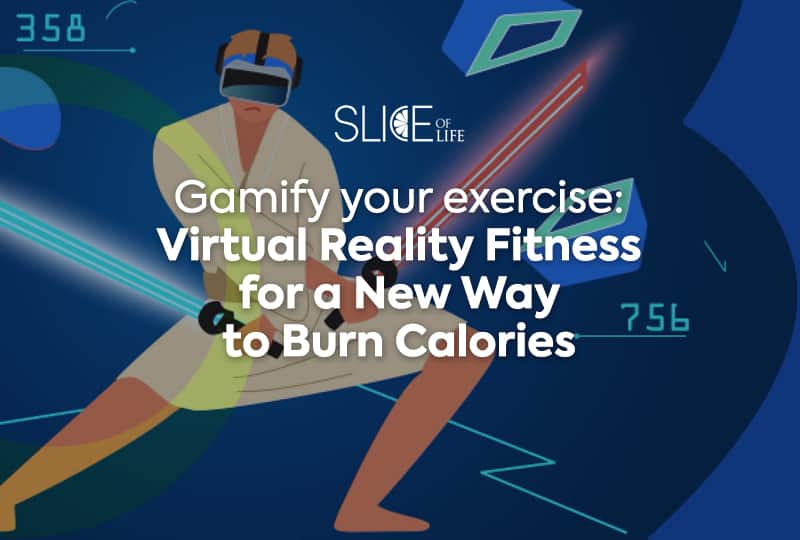Even if you are a major fitness junkie who loves hitting the gym and working up a good sweat, the same typical exercise routine week-in and week-out can get pretty old, as well as potentially lead to a plateau in progress on fitness goals. So, what can you do to change up your fitness regimen, burn calories and have fun at the same time? Many people are turning to different kinds of fantastical new technologies to boost their workouts. Today we are going to look at the rising trend in Virtual Reality (VR) Fitness.
For the sake of narrowing our scope, we will look at the most popular VR headset currently on the market: The Meta Quest 2 (previously known as the Oculus Quest 2). This system offers a wide range of well-liked and enjoyable games that get you moving, such as Supernatural and Beat Saber. We will look at the some of these games in more detail later, but first let’s look at the potential benefits of VR fitness as a whole.
VR Fitness Upsides
The Washington Post published a comprehensive exploration into the VR Fitness landscape with their article “Let’s get Meta-physical: Why Oculus fitness actually works.” The article noted a significant uptick in Google searches for VR Fitness in January 2022, as well as roughly a quarter of online adults in the U.S. reporting an interest in purchasing a VR headset, according to research company Forrester. Of those surveyed, 18% said they primarily want a headset for exercise purposes.
The Virtual Reality Institute of Health and Exercise (VRHI) is an independent research body dedicated to studying the health impact of virtual and augmented reality. The VRHI collaborated with the Washington Post to demonstrate how they have found that popular VR fitness apps can offer as vigorous a workout as common real-world exercise plans. Jimmy Bagley, Lead Researcher at VRHI and Associate Professor of Kinesiology at San Francisco State University, co-authored a 2018 paper that provided evidence that exercising in virtual reality leads people to underestimate just how much they are exerting. In other words, VR Fitness can often feel like you are not exercising as thoroughly as you actually are, which could help with stamina.
Tatum Hunter, the writer for the Washington Post article, tested four VR Fitness games at the VR Institute to get a fuller picture of their effectiveness as fitness tools.
The first game he took on was Supernatural, a multi-faceted gaming platform that gives users the ability to work out in beautiful destinations all over the world, allowing for boxing, stretching, meditation and more. When VRHI tested subjects over 30 minutes of gameplay, it raised their metabolic rates on average to the same level as riding a bike, which is typically 11.44 times their resting rate, also known as 11.44 METs, standing for metabolic equivalent of task.
Hunter also tried out The Thrill of the Fight, an aptly named boxing game with a MET score of 9.28, slightly over a standard cross-country skiing score. The third game tested, FitXR, has a variety of offerings ranging from boxing, dancing and interval training. It came in at 7.94 METs, pretty close to a singles tennis workout. Lastly, Until You Fall, a sword-fighting adventure game, reached 6.5 METs, a bit above resistance training. And surprisingly for Nintendo Wii lovers, the Wii Fit only scores 3.8 METs. That’s interesting, as Wii seemed to be the leader for a long time for fitness-related games, but VR Fitness packs a punch that might give them a run for their money.
Challenges for VR Fitness
Getting started with VR workouts can come with some obstacles to overcome. This is still relatively new technology. It will most likely improve over time, so some people who are on the fence might prefer to wait it out until VR is at a more advanced stage. Some complaints that people cite now relate to the headsets being bulky, collecting sweat and even causing them to feel sick. Disorientation can occur when the virtual environment doesn’t line up with a user’s physical movements, according to experts cited in the Washington Post.
Like all early technology, VR has a long way to go before it reaches optimum stages, so the issues that users are reporting now should dissipate. It is important to note as well that all movement-friendly games come with some risk of injury, and VR perhaps even more so since you cannot see your true environment while playing. Be sure to use a VR headset in a safe environment with a fair amount of space around you to move.
Cost is also a factor that forces many to pause. The Meta Quest 2 headset is sold for $400 on the manufacturer’s site, so it’s certainly not going to be an impulse buy for most people. Not to mention, the games themselves often require subscription fees, though there are some free games.
Lastly, there is some concern surrounding privacy and data mining. As Meta is the parent company of Facebook, the headset requires users to log in using a Facebook profile. That might not be a big deal to those already using the platform, but for those that are wary of how Facebook might use their data for professional gain, it might sour them to the prospect.
Whether you decide to try out VR Fitness or not, it is always fascinating to learn about new ways to think about staying fit. Get out there and break a sweat!
Slice of LIFE is an invitation to and extension of everything happening at Life University. Whether you are a current student, a potential freshman or a proud alumni, Slice of LIFE can help keep you connected to your academic community. Know of a compelling Life U story to be shared, such as a riveting project, innovative group or something similar? Let us know by emailing Marketing@life.edu.


Social Media